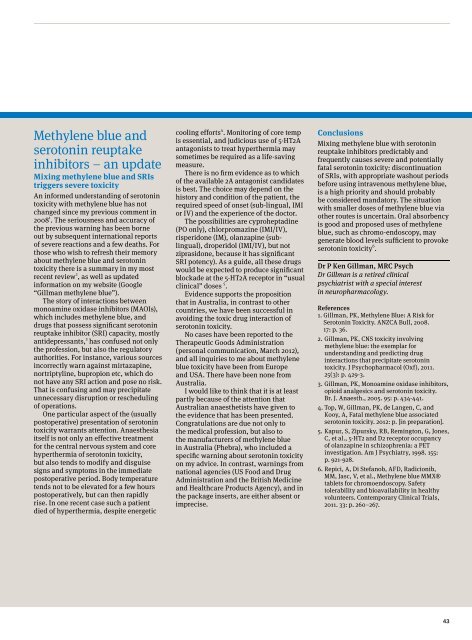ANZCA Bulletin June 2012 - final.pdf - Australian and New Zealand ...
ANZCA Bulletin June 2012 - final.pdf - Australian and New Zealand ...
ANZCA Bulletin June 2012 - final.pdf - Australian and New Zealand ...
- No tags were found...
You also want an ePaper? Increase the reach of your titles
YUMPU automatically turns print PDFs into web optimized ePapers that Google loves.
Methylene blue <strong>and</strong>serotonin reuptakeinhibitors – an updateMixing methylene blue <strong>and</strong> SRIstriggers severe toxicityAn informed underst<strong>and</strong>ing of serotonintoxicity with methylene blue has notchanged since my previous comment in2008 1 . The seriousness <strong>and</strong> accuracy ofthe previous warning has been borneout by subsequent international reportsof severe reactions <strong>and</strong> a few deaths. Forthose who wish to refresh their memoryabout methylene blue <strong>and</strong> serotonintoxicity there is a summary in my mostrecent review 2 , as well as updatedinformation on my website (Google“Gillman methylene blue”).The story of interactions betweenmonoamine oxidase inhibitors (MAOIs),which includes methylene blue, <strong>and</strong>drugs that possess significant serotoninreuptake inhibitor (SRI) capacity, mostlyantidepressants, 3 has confused not onlythe profession, but also the regulatoryauthorities. For instance, various sourcesincorrectly warn against mirtazapine,nortriptyline, bupropion etc, which donot have any SRI action <strong>and</strong> pose no risk.That is confusing <strong>and</strong> may precipitateunnecessary disruption or reschedulingof operations.One particular aspect of the (usuallypostoperative) presentation of serotonintoxicity warrants attention. Anaesthesiaitself is not only an effective treatmentfor the central nervous system <strong>and</strong> corehyperthermia of serotonin toxicity,but also tends to modify <strong>and</strong> disguisesigns <strong>and</strong> symptoms in the immediatepostoperative period. Body temperaturetends not to be elevated for a few hourspostoperatively, but can then rapidlyrise. In one recent case such a patientdied of hyperthermia, despite energeticcooling efforts 4 . Monitoring of core tempis essential, <strong>and</strong> judicious use of 5-HT2Aantagonists to treat hyperthermia maysometimes be required as a life-savingmeasure.There is no firm evidence as to whichof the available 2A antagonist c<strong>and</strong>idatesis best. The choice may depend on thehistory <strong>and</strong> condition of the patient, therequired speed of onset (sub-lingual, IMIor IV) <strong>and</strong> the experience of the doctor.The possibilities are cyproheptadine(PO only), chlorpromazine (IMI/IV),risperidone (IM), olanzapine (sublingual),droperidol (IMI/IV), but notziprasidone, because it has significantSRI potency). As a guide, all these drugswould be expected to produce significantblockade at the 5-HT2A receptor in “usualclinical” doses 5 .Evidence supports the propositionthat in Australia, in contrast to othercountries, we have been successful inavoiding the toxic drug interaction ofserotonin toxicity.No cases have been reported to theTherapeutic Goods Administration(personal communication, March <strong>2012</strong>),<strong>and</strong> all inquiries to me about methyleneblue toxicity have been from Europe<strong>and</strong> USA. There have been none fromAustralia.I would like to think that it is at leastpartly because of the attention that<strong>Australian</strong> anaesthetists have given tothe evidence that has been presented.Congratulations are due not only tothe medical profession, but also tothe manufacturers of methylene bluein Australia (Phebra), who included aspecific warning about serotonin toxicityon my advice. In contrast, warnings fromnational agencies (US Food <strong>and</strong> DrugAdministration <strong>and</strong> the British Medicine<strong>and</strong> Healthcare Products Agency), <strong>and</strong> inthe package inserts, are either absent orimprecise.ConclusionsMixing methylene blue with serotoninreuptake inhibitors predictably <strong>and</strong>frequently causes severe <strong>and</strong> potentiallyfatal serotonin toxicity: discontinuationof SRIs, with appropriate washout periodsbefore using intravenous methylene blue,is a high priority <strong>and</strong> should probablybe considered m<strong>and</strong>atory. The situationwith smaller doses of methylene blue viaother routes is uncertain. Oral absorbencyis good <strong>and</strong> proposed uses of methyleneblue, such as chromo-endoscopy, maygenerate blood levels sufficient to provokeserotonin toxicity 6 .Dr P Ken Gillman, MRC PsychDr Gillman is a retired clinicalpsychiatrist with a special interestin neuropharmacology.References1. Gillman, PK, Methylene Blue: A Risk forSerotonin Toxicity. <strong>ANZCA</strong> Bull, 2008.17: p. 36.2. Gillman, PK, CNS toxicity involvingmethylene blue: the exemplar forunderst<strong>and</strong>ing <strong>and</strong> predicting druginteractions that precipitate serotonintoxicity. J Psychopharmacol (Oxf), 2011.25(3): p. 429-3.3. Gillman, PK, Monoamine oxidase inhibitors,opioid analgesics <strong>and</strong> serotonin toxicity.Br. J. Anaesth., 2005. 95: p. 434-441.4. Top, W, Gillman, PK, de Langen, C, <strong>and</strong>Kooy, A, Fatal methylene blue associatedserotonin toxicity. <strong>2012</strong>: p. [in preparation].5. Kapur, S, Zipursky, RB, Remington, G, Jones,C, et al., 5-HT2 <strong>and</strong> D2 receptor occupancyof olanzapine in schizophrenia: a PETinvestigation. Am J Psychiatry, 1998. 155:p. 921-928.6. Repici, A, Di Stefanob, AFD, Radicionib,MM, Jasc, V, et al., Methylene blue MMX®tablets for chromoendoscopy. Safetytolerability <strong>and</strong> bioavailability in healthyvolunteers. Contemporary Clinical Trials,2011. 33: p. 260–267.43
















